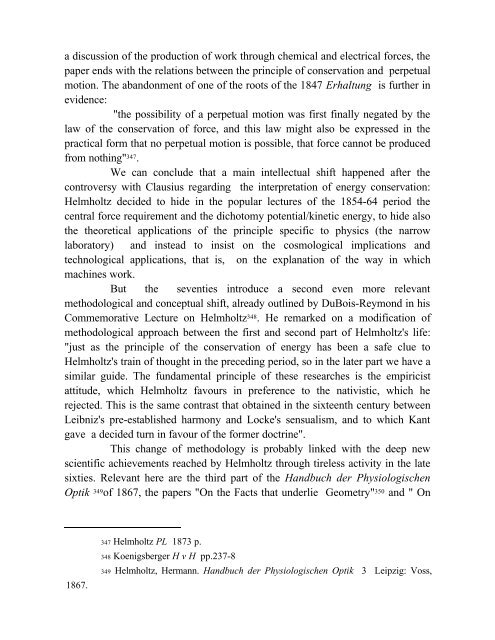Conservation and Innovation : Helmholtz's Struggle with Energy ...
Conservation and Innovation : Helmholtz's Struggle with Energy ...
Conservation and Innovation : Helmholtz's Struggle with Energy ...
You also want an ePaper? Increase the reach of your titles
YUMPU automatically turns print PDFs into web optimized ePapers that Google loves.
a discussion of the production of work through chemical <strong>and</strong> electrical forces, the<br />
paper ends <strong>with</strong> the relations between the principle of conservation <strong>and</strong> perpetual<br />
motion. The ab<strong>and</strong>onment of one of the roots of the 1847 Erhaltung is further in<br />
evidence:<br />
"the possibility of a perpetual motion was first finally negated by the<br />
law of the conservation of force, <strong>and</strong> this law might also be expressed in the<br />
practical form that no perpetual motion is possible, that force cannot be produced<br />
from nothing" 347.<br />
We can conclude that a main intellectual shift happened after the<br />
controversy <strong>with</strong> Clausius regarding the interpretation of energy conservation:<br />
Helmholtz decided to hide in the popular lectures of the 1854-64 period the<br />
central force requirement <strong>and</strong> the dichotomy potential/kinetic energy, to hide also<br />
the theoretical applications of the principle specific to physics (the narrow<br />
laboratory) <strong>and</strong> instead to insist on the cosmological implications <strong>and</strong><br />
technological applications, that is, on the explanation of the way in which<br />
machines work.<br />
But the seventies introduce a second even more relevant<br />
methodological <strong>and</strong> conceptual shift, already outlined by DuBois-Reymond in his<br />
Commemorative Lecture on Helmholtz 348. He remarked on a modification of<br />
methodological approach between the first <strong>and</strong> second part of <strong>Helmholtz's</strong> life:<br />
"just as the principle of the conservation of energy has been a safe clue to<br />
<strong>Helmholtz's</strong> train of thought in the preceding period, so in the later part we have a<br />
similar guide. The fundamental principle of these researches is the empiricist<br />
attitude, which Helmholtz favours in preference to the nativistic, which he<br />
rejected. This is the same contrast that obtained in the sixteenth century between<br />
Leibniz's pre-established harmony <strong>and</strong> Locke's sensualism, <strong>and</strong> to which Kant<br />
gave a decided turn in favour of the former doctrine".<br />
This change of methodology is probably linked <strong>with</strong> the deep new<br />
scientific achievements reached by Helmholtz through tireless activity in the late<br />
sixties. Relevant here are the third part of the H<strong>and</strong>buch der Physiologischen<br />
Optik 349of 1867, the papers "On the Facts that underlie Geometry" 350 <strong>and</strong> " On<br />
1867.<br />
347 Helmholtz PL 1873 p.<br />
348 Koenigsberger H v H pp.237-8<br />
349 Helmholtz, Hermann. H<strong>and</strong>buch der Physiologischen Optik 3 Leipzig: Voss,
















